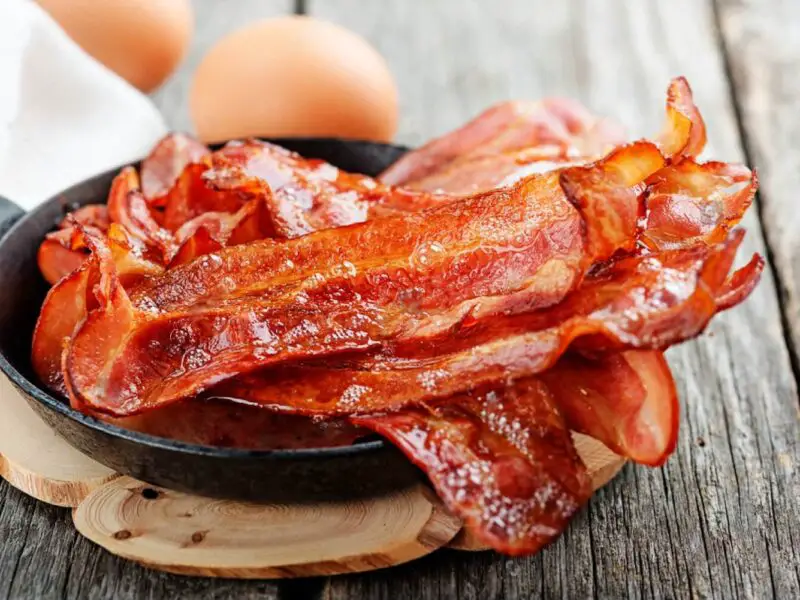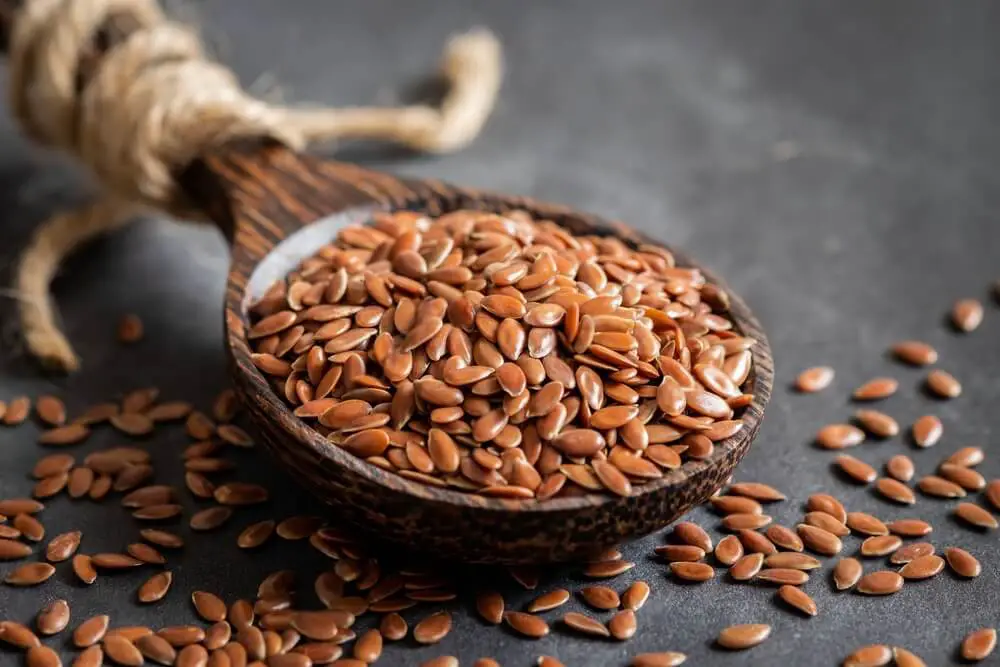Ah, bacon – that sizzling, savory, and somewhat sinful delight that graces breakfast tables around the world. But have you ever wondered why is bacon so salty? The answer lies in the mysterious world of bacon-making, and we’re here to break it down for you.
Why is Bacon So Salty?
Bacon, in all its mouthwatering glory, is a cured pork belly. This curing process involves either a wet brine or a dry salt mixture, followed by the possibility of smoking. So, if you’ve ever wondered why your bacon is too salty, the answer lies in the curing process.
To put it simply, curing meat is a method of preservation. It can be done using a wet brine (a salt solution) or a dry salt mixture. Additional ingredients, such as sugar, nitrites, nitrates, and various seasonings, can be added to the mix. Once the bacon is cured, it can be smoked or aged, further enhancing its flavor.
However, sometimes bacon turns out saltier than expected, usually due to an extended curing time or an excessive amount of salt used. Smoking, which adds a delightful smoky flavor, can also intensify the saltiness of the bacon.
Before we dive into the nitty-gritty, here’s a little fact: even before bacon enters the picture, pork itself contains a notable amount of sodium. However, the transformation from plain pork to savory bacon involves a series of intriguing steps that add that signature saltiness.
Bacon’s Journey: From Pork to Salty Bliss
Curing with Salt
The first secret to bacon’s allure is the curing process. Pork is brined with salt, often seasoned with sodium nitrate – another salty ingredient. This brining is the best way to preserve the meat, keeping it free from dangerous bacteria and humidity and thus prolonging the meat’s shelf life. In addition to salt, curing often involves the use of sodium nitrates or sodium nitrites (curing salt), which preserve the pork’s color and speed up the curing process. Unfortunately, these additives also contribute to the overall saltiness of bacon.
The Smoking and Drying
After the curing process, the meat is typically dried or smoked. The brined pork belly is left to marinate in the brine solution for 10 to 14 weeks, allowing the flavors to meld. The brine itself consists of water, salts, and sugars, and some manufacturers get creative by adding spices like thyme, rosemary, or garlic for an extra flavor punch. Once the pork has soaked up all the goodness, it’s time for the grand finale – grilling or smoking over a wood fire, giving the bacon its unique texture and flavor.
When Bacon Gets a Bit Too Salty?
Sometimes, your bacon can turn out saltier than you’d like, and here’s why: the curing process may extend for too long, or you might have used an excess of salt. To reduce the saltiness when making bacon at home, consider a shorter curing time – around 5 days. You can also opt for kosher or table salt in the brine mix.
If you find yourself with overly salty bacon, fear not – there are solutions. Sugar comes to the rescue, as it can help balance out the saltiness. Adding brown sugar, white sugar, or even a dash of paprika to your brining mixture can work wonders.
What to Do If Your Bacon is Too Salty?
Whether you’re making your own bacon or working with store-bought slices, there are ways to remedy overly salty bacon. Here are some tips to help you navigate this salty situation:
Making Your Own Bacon? Consider These Steps:
- Thin Slices: Choose thinner-cut bacon strips. The fat in bacon contributes to its salty flavor, so opting for thinner slices can help reduce the saltiness.
- Opt for a Wet Brine: If you’re concerned about the salt content in your bacon, consider using a wet brine instead of a dry cure. Wet brining penetrates the meat differently, and the water content helps balance the salt.
- Balance with Sugar and Seasonings: Add brown sugar, pepper, and other seasonings to the mix along with the salt to balance the flavor. Sugar, in particular, can counteract the saltiness.
- Moderate the Salt: Be mindful not to overdo the salt. Since curing salt is already being used, consider reducing the amount of kosher salt for flavor purposes.
- Shorten the Curing Time: While many recipes suggest curing bacon for 3 to 10 days, opting for the shorter end of the spectrum (around 3 days) can help control saltiness.
Remember, it’s easier to remove salt from uncooked bacon than cooked bacon. So if your bacon has already met the heat, these tricks might be less effective.
How to Remove Salt From Bacon That’s Too Salty
If you find your bacon is too salty, there are ways to remedy the situation, whether your bacon is raw or already cooked:
For Raw Bacon:
- Pre-Cook Soak: Soaking the bacon in cold water for about 30 minutes before cooking can be a game-changer. Dry off a piece and cook it to test the saltiness. If it’s still too salty, start the process over with fresh water. Keep in mind that this process may remove some of the bacon’s smoky flavor. You can also simmer it in a frying pan with boiling water for a minute, which helps remove some of the excess salt and makes it a healthier option.
- Adjust Recipes: If you plan to use the bacon in a recipe, consider reducing the amount of salt or removing it altogether. Use the bacon for flavor without adding extra salt.
- Quick Boil: If you’re short on time, briefly boil the raw bacon in water, then dry it with a paper towel before cooking.
For Cooked Bacon:
- Caramelize with Brown Sugar: If you’re planning to eat the bacon on its own, sprinkle it with brown sugar and cracked black pepper. Quickly broil it to caramelize the sugar or use a kitchen torch. This will add a delicious candied flavor while offsetting the saltiness without making it overly sweet.
- Drizzle Maple Syrup: If you’re serving the bacon with breakfast, drizzle some maple syrup to help balance the saltiness with sweetness.
- Modify Recipe Ingredients: If you’re using the bacon in a recipe, consider using less bacon and reducing the overall salt content of the dish. Ingredients like potatoes, cream, butter, or pasta can naturally absorb some of the saltiness.
Does Removing Salt From Bacon Ruin Its Taste?
Removing salt from bacon can alter its taste slightly. Soaking raw bacon in water, for instance, can diminish the bacon’s smokiness and other flavors. It won’t necessarily ruin its taste, but expect some subtle changes.
Why is Salt Used in Curing Pork?
The primary reason for using salt in curing pork is to preserve the meat and protect it from harmful bacteria and mold. Curing removes moisture, creating an environment less conducive for bacterial growth. This process is crucial for extending the shelf life of meats like beef jerky and, of course, bacon.
Smoked or Unsmoked?
There are two types of bacon: smoked and unsmoked. Unsmoked bacon is typically saltier, while smoked bacon is milder and more flavorful. If you’re looking for a bacon option with a lower salt content, smoked bacon, such as pancetta di maiale, is a great choice. It’s noticeably tastier and less salty. However, do note that smoked bacon is not fully cooked bacon.
The Role of Packaging
Ever wondered why bacon stays fresh for longer periods? It’s all thanks to clever packaging. However, this method often involves using more sodium to seal in freshness, which can lead to increased saltiness. So, when shopping for bacon, it’s a good idea to compare sodium levels on labels and choose the one that suits your preferences.
Is Your Bacon Too Salty? How to Know
You might be wondering how to tell if your bacon is too salty. Unfortunately, you can’t always judge it by appearance or taste. The best way to determine sodium levels is by checking the labels. Typically, one ounce of bacon contains about 233 milligrams of sodium, which is less than the daily allowance recommended by health authorities. When sodium levels exceed this range, especially when paired with other salty elements like bread or eggs, it can lead to excessive salt intake, which is associated with health concerns like stomach issues and high cholesterol.
Should You Remove Salt from Bacon?
While reducing the salt content in bacon can enhance its taste, it’s not advisable during the curing process. Inadequate salt during curing may reduce the preservation function of the cure. It’s better to remove excess salt before or during cooking, using the methods we mentioned earlier.
Low-Salt Bacon Alternatives
If you’re looking to reduce your sodium intake but still enjoy bacon, here are some alternatives to consider:
- Make Your Own Bacon: Making your own bacon allows you to control the amount of salt used.
- Uncured Bacon: This variety contains lower sodium nitrite content and is processed using natural preservatives. While it often contains the same sodium as cured bacon, it avoids chemically derived preservatives.
- Beef Bacon: Made from beef, this type is brined with sugar and spices and tends to have less sodium compared to pork bacon.
- Vegan Bacon: Plant-based bacon alternatives exist, but they may not taste exactly like bacon. While their sodium content is slightly lower than that of pork bacon, they offer a different flavor profile.
- Turkey Bacon: A lighter alternative to pork bacon, turkey bacon generally has less sodium. It’s a healthier choice for those looking to reduce their sodium intake.
- Lamb Bacon: Made from lamb legs and brined with salt and sugar, lamb bacon has a rich flavor but tends to be higher in sodium compared to pork bacon.
- Pancetta: Pancetta, a cured pork product without smoking, offers a slightly less salty flavor. It’s rich in taste, so you won’t need as much in your recipes.
In Conclusion
Bacon, the salty delight of breakfast tables, owes its saltiness to the curing process it undergoes. While you can’t measure bacon’s saltiness by sight or taste, you can check labels for sodium content to make an informed choice. If your bacon turns out saltier than you prefer, fear not – there are ways to balance it out and enjoy your favorite breakfast treat without overindulging in salt.



